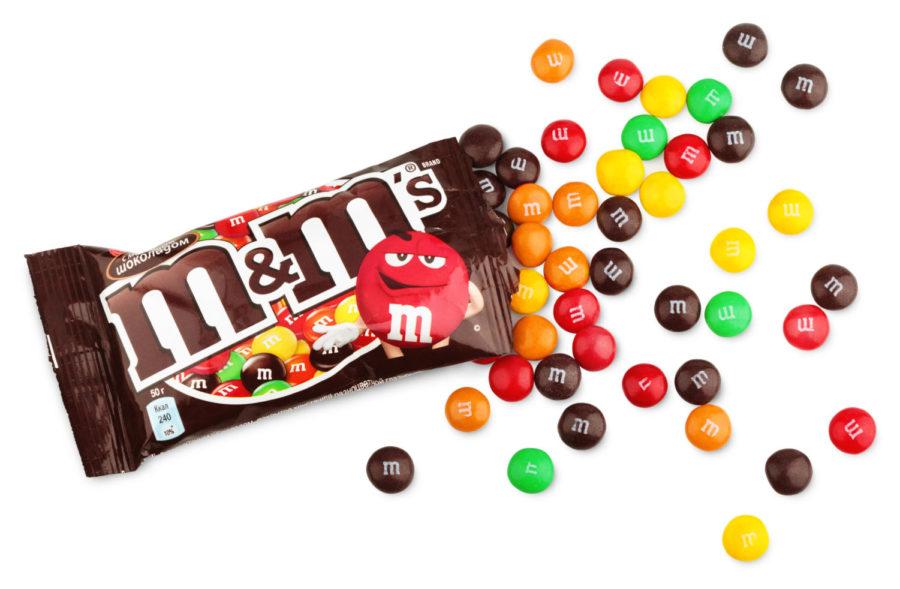What it means to give up added sugar
spilled m&m’s
April 4, 2019
I was at the store with my younger sister when I stumbled upon a book about a family who gave up added sugar for a year.
After reading this book and watching a BBC documentary, I began to question what sugar really did for the body, and I wanted to know what a low-sugar or no-added-sugar diet would really look like. On March 16, I began a journey by giving up the thing I once held so dear: added sugar.
Kallen Anderson, the registered dietician for ISU Dining, said sugars are a form of carbohydrates found in grains, vegetables, fruits and our dairy products. Anderson said added sugars are added to a food product or to a food item to give it extra flavor or to help with its preservation process so it will stay good longer. Foods like jams and jellies need sugar to be shelf stable, otherwise they will go bad quicker due to a bacteria growth that causes botulism.
I knew I ate a lot of foods high in added sugar. Snacks like candy, chocolate, cookies and cakes quickly became out of the question. The American Heart Association (AHA) website recommends limiting the amount of added sugars to no more than half of the daily discretionary calories allowance. For most American women, that’s no more than 100 calories per day, or about six teaspoons of sugar. For men, it’s 150 calories per day or about nine teaspoons. According to a package of Peanut M&M’s, one serving includes 25 grams of sugar or six teaspoons – the AHA’s daily recommended allowance.
I quickly found the majority of foods I eat have some form of sugar in them, including ketchup and bread. According to a study done by the University of North Carolina in 2015, 60 percent of packaged foods found in an American grocery store included some form of added sugar. When they looked at every processed food in the store, 68 percent had added sugar.
“Sugar in itself is not a bad thing,” Anderson said. “It’s in so much of what we eat, and our body needs it to survive and to function properly, but too much of it can be a little bit overbearing.”
I realized straight away giving up sugar was not an option. I didn’t want to restrict myself into something that was not going to be sustainable in the long run. I began focusing my efforts on limiting the snacks and frozen foods I was eating daily that included added sugars. I wanted to find a balance.
Anderson said she doesn’t believe in giving up sugar or added sugar.
“I see so many diet plans or fad diets,” Anderson said. “They are all the same thing. It’s all a part of diet culture, which is telling us that we need to look a certain way, be a certain way, have a certain size and shape of body and we are supposed to eat this way to be healthy, which doesn’t work.”
I began switching out the instant oatmeal and sugary cereals I normally ate for breakfast for homemade oatmeal, including fresh fruit and cinnamon for flavor, and cereals like Cheerios. For lunch and dinner, I started grilling chicken for meals like quesadillas and salads and skipped the frozen TV meals.
The biggest changes I made were choosing to eat carrots and apples and drinking water instead of brownies and soda. I looked at the ingredients on packages and the amounts of added sugars and realized I could find something else much more filling simply by walking over to the produce or dairy section and incorporating it in to my meals.
This experiment was not about losing weight for a diet. It was originally about seeing if a no-added-sugar diet was sustainable. Two weeks after I began, I weighed myself for a comparison. I did lose weight. In fact, I lost four pounds.
“That’s just diet culture – trying to play the blame game on a specific food or a specific ingredient,” Anderson said. “Any restrictive diet helps you lose weight no matter what it is. Once you go off of that diet, it doesn’t teach you a skill, and it doesn’t help you.”
Anderson said because a lot of college students are on their own for the first time and are able to choose from the wide variety of foods on campus, they will often choose a little bit of everything like pizza, Chinese food and sandwiches and don’t listen to their natural hunger cues.
Paige Stropes, a junior majoring in industrial engineering, said she consumes a lot of sugar-filled foods throughout the day.
“It’s sad, but it isn’t really that shocking,” Stropes said. “I know I probably eat too much of one thing some days, but I think I do an overall good job eating in moderation.”
Anderson said she recommends eating a balanced diet. She also suggests meeting with one of the dieticians on campus, either her, for students with a meal plan, or Lisa Nolting, the dietician for students without a meal plan.
“If you are eating well-balanced meals and diet beforehand, you can have a soda to go with it,” Anderson said. “You are probably getting all of the nutrients that your body needs from the regular food you eat. Having a treat every once in a while, like a soda or a cookie, is totally normal.”







